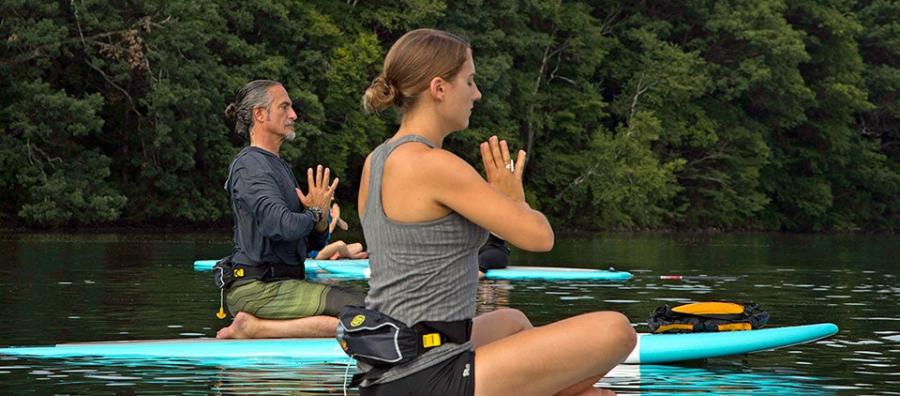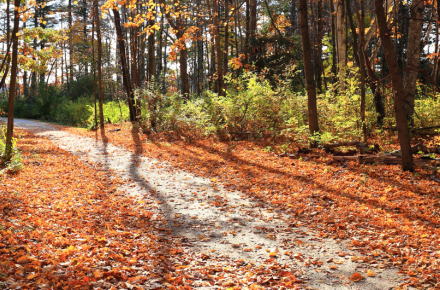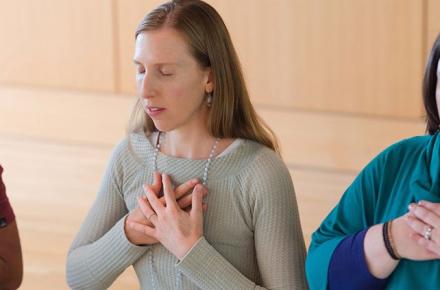Teaching Yoga on the Water: A Q&A with Anna Levesque

Anna Levesque has spent a good portion of her life on the water. She is an international paddling, yoga, and Ayurveda wellness coach who was voted Most Inspirational Outdoors Person in Best of the Blue Ridge 2017, and named one of the most inspirational paddlers alive by Canoe and Kayak Magazine. In this Q&A, she talks about the skills—and the surrender—that support yoga teachers when taking their students from the mat to the paddleboard.
Beyond practical knowledge, such as water safety, what are some of the primary skills for teaching standup paddleboard (SUP) yoga that a traditional yoga training does not offer?
SUP yoga teacher training takes your awareness, both group and environmental, up a notch. When you're teaching outside and on the water, you learn to broaden your vision, project your voice, and become mindful of what is happening with your students and what is happening in nature. You learn to take cues from the natural environment, as well as your inner knowing.
I recently heard an excerpt from a talk by Ayurvedic doctor and yoga practitioner Robert E. Svoboda, who talked about the importance of reading omens in nature. During SUP yoga teacher training, your connection with nature deepens, and you learn how to incorporate messages from the natural world into teachable moments throughout class.
How do yoga teachers need to shift the way they think about yoga and postures in order to adapt to this new environment?
One thing I love about SUP yoga is that you aren't just referencing nature and the five elements in class, you're practicing in nature, immersed in the five elements. This gives you an opportunity to connect your students with the truth that WE ARE nature—that we are all interconnected with each other and with all beings who call the planet home. This is an easy shift to make when the water is the floor and the sky the ceiling of the yoga “studio”!
SUP yoga is an effective way to bring greater awareness to imbalances in the body and move the body toward optimal alignment. Not only do you as the teacher become aware of how you compensate by overusing or underusing muscles in certain poses on land, you learn how to recognize it in your students. For example, on land, it may be easy for us to lean back in poses like Side Angle or Triangle, but if you shift our weight back when practicing these poses on a board, you'll fall in pretty quickly! Once you have this awareness, the poses become more powerful and balanced as you learn to press down through the feet and find perfect balance and strength without compensating by leaning back. SUP yoga takes the concept of sthira and sukha [effort and ease] to a new level!
Also, the balance piece of SUP yoga makes “easy” poses, like low lunge, more difficult, and there is a whole new world to be discovered in infusing greater power, balance, and ease in poses that you might take for granted in the studio.
It's important to let go of strict alignment principles or foot and hand placement when teaching SUP yoga. For instance, some students may need to widen their stance in Warrior I to be able to balance on the board. We don't want to force students to have their front heel in line with the arch of the back foot in Warrior I if they can’t hold it without falling in. Falling in is part of the deal, and we want to set people up for success by being flexible and adaptable. In SUP yoga Teacher training, we learn how to explore poses in a whole new context of balance.
As far as safety goes, it's important for SUP yoga teachers to consider that certain poses are not appropriate to teach in a SUP yoga class, such as Headstand, Shoulderstand, Handstand, or any pose that may compromise the neck and head. For some reason, a lot of people come to SUP yoga and want to try poses that they don't even try or practice on land! We learn effective group management for outdoor and water environments in SUP yoga Teacher training that traditional yoga trainings don't address.
Are there certain postures, sequences, and transitions that are completely or substantially different when practiced on a paddleboard vs. on a mat?
Yes! The fewer points of contact a pose has with the board the more difficult it is. Poses with lots of contact—such as Savasana, Cobra, poses on hands and knees, or seated poses—feel different, but not that different. As soon as you go from all fours to tabletop (four points of contact with the board to two points of contact), the pose becomes much more challenging and you get a sense of what big muscles tend to take over for your core when you're on your mat. This muscles grip even tighter when you're on the board and that doesn't work as well, so you learn to go to the source and engage your core more effectively.
Poses like Dancer or Tree, where there is only one point of contact, become extremely difficult and aren't recommended when teaching, but we like to play around with them in SUP yoga teacher training!
How do the natural surroundings in which SUP yoga is practiced affect the experience, and how can yoga teachers mindfully enhance that experience?
Practicing in nature can give us great insight into our stress-response levels, help us cultivate a higher degree of inner focus, and open us up to receiving messages from the natural world that help us along our spiritual journey.
If we freak out about every bug that lands on us or get startled by noises that we hear while practicing outside, that is a cue that our stress response may be stuck on high alert. It is a beautiful practice to feel insects land on you or hear a fish jump or voices in the distance, and practice being with whatever is happening without reacting or letting your attention get hijacked. It's not possible to practice this in a studio because the environment is very controlled.
Teaching outside brings new meaning to “teachable moments.” When an eagle or hawk fly overhead, we're reminded to pay attention and listen to our inner knowing that is connected to the Divine Source. When an otter pokes its head out of the water, we're reminded to be playful in our lives and in our practice. When we hear the buzzing of a bee, we're reminded that the impossible is possible. If a deer is rustling in the woods, we may be inspired to walk gently yet sure-footedly upon the earth. It is very powerful to practice outside and tune into the messages from the natural world that surround us.
Do SUP yoga teachers need to have special skills for addressing students’ fears or nervousness on the water?
I don't think special skills are required, but I do think that teaching SUP yoga enhances our awareness that we really don't know another person's story or experience. Fear may be more present in a SUP yoga class than in a studio, because of the water element and because of the extra balance required—fear of water, fear of failure, fear of looking bad, fear of falling in, fear of not doing it “right.” This is an opportunity for teachers to flex their compassion muscle and remember that we don't teach paddling or yoga, we teach people.
What skills learned in SUP yoga teacher training can yoga teachers bring back to a traditional mat class?
Besides greater group awareness and group management, I think that one of the most transformational aspects of SUP yoga teacher training is dropping the striving for perfection. SUP yoga teachers are effective at teaching outside in an environment that they can't control (can't turn up the heat, turn down the heat, turn on music, etc.), they cultivate an awareness of the micro and macro happening within and without, and they have the ability to let go of thinking that a class has to look a certain way or have certain things (like props). SUP yoga teachers are very effective in emulating water by going with the flow, which allows them to teach from a very intuitive place.
© Kripalu Center for Yoga & Health. All rights reserved. To request permission to reprint, please email editor@kripalu.org.
















































